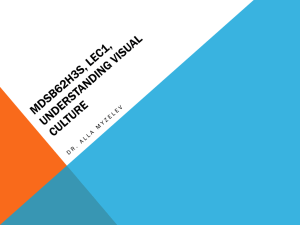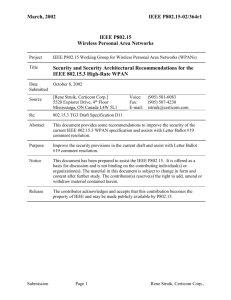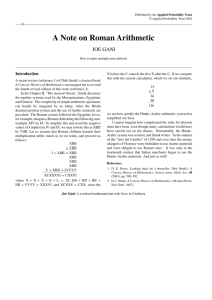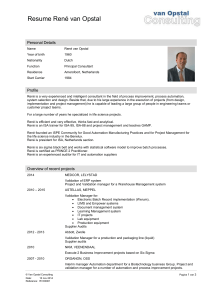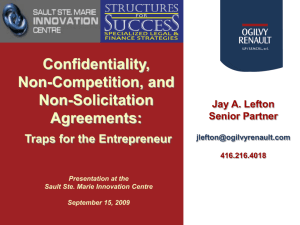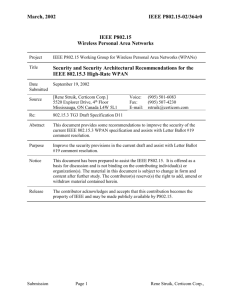core-2
advertisement
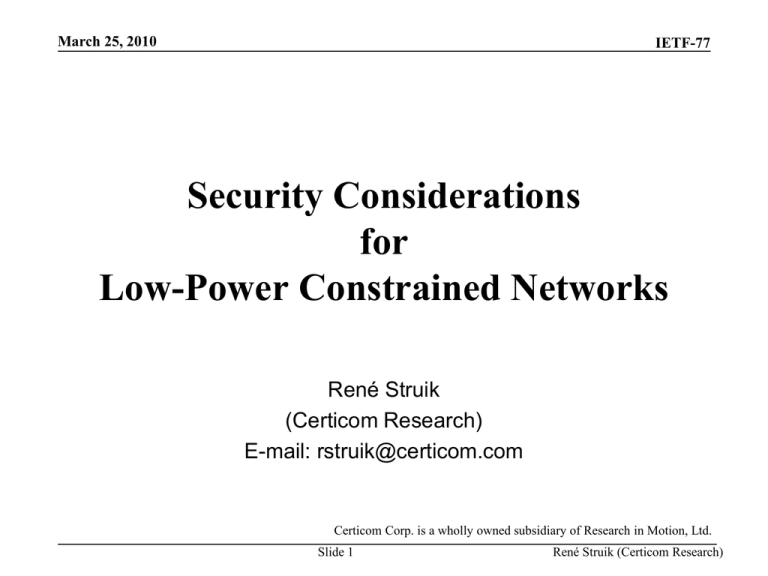
March 25, 2010 IETF-77 Security Considerations for Low-Power Constrained Networks René Struik (Certicom Research) E-mail: rstruik@certicom.com Certicom Corp. is a wholly owned subsidiary of Research in Motion, Ltd. Slide 1 René Struik (Certicom Research) March 25, 2010 IETF-77 The “Holy Grail”: Security and Ease of Use “Computer users have been taught for years that computer security systems can’t be effective unless they are complex and difficult to use. In reality, this conventional wisdom is completely wrong.” Lorrie Faith Cranor, Carnegie Mellon University Security technology can make trust lifecycle management intuitive and hidden from the user. Source: D. Balfanz, G. Durfee, R.E. Grinter, D.K. Smetters, P. Stewart, “Network-in-a-Box: How to Set Up a Secure Wireless Network in under a Minute,” in Proceedings of the 13th USENIX Security Symposium, August 9-13, 2004. Slide 2 René Struik (Certicom Research) March 25, 2010 IETF-77 Ease of Configuration and Reconfiguration Ease of configuration: Merging of networks Partitioning of networks Device portability and orphaning Hand-over of control (remote, backup) Synchronization and failure recovery Slide 3 René Struik (Certicom Research) March 25, 2010 Feasibility of Crypto on Small Devices IETF-77 Conventional wisdom: Symmetric-key cryptographic functionality, let alone publickey cryptographic functionality, are expensive to implement with sensor networks. Status anno 2008: conventional wisdom challenged for all but most mundane devices. Examples: Bluetooth v2.1, ZigBee Smart Metering, RFID e-Passport. • ZigBee Smart Energy Profile Certificate Structure: 22 octets 8 octets 8 octets 10 octets Public Key Device DeviceId CA Id AttributeData Ctrl ProfileId Serial# ManufacturerData • Low-energy hardware implementations: Sensors1 clock frequency #gates CMOS process Energy exp.: Computation Smart 2 MHz ~10 kgates 130nm ~ 250 J signature verify Slide 4 (total: 48 octets) RFID2 10 MHz ~100 kgates 250nm < 100 J point multiple Less than energy expenditure single IEEE 802.15.4 frame! Sources: 1Certicom-internal 2SAC 2008 conference René Struik (Certicom Research) March 25, 2010 IETF-77 Deployment Scenarios vs. Security Design Diverse deployment scenarios • Home Automation draft-ietf-roll-home-routing-reqs-11 • Building Automation draft-ietf-roll-building-routing-reqs-09 • Urban Settings RFC 5548 - Routing Requirements for Urban Low-Power and Lossy Networks (May 2009) • Industrial Control RFC 5673 - Industrial Routing Requirements (October 2009) ZigBee, ISA SP100.11a, “smart grid”, “Internet of Things”, etc. Actual security design Unified design that fits these diverse deployment scenarios – concise set of cryptographic and security mechanisms; – single security policy framework; – configuration parameters application-dependent. This allows for mass-scale production, while still allowing for customization (e.g., as to security services provided, granularity of assurances, used keys, device roles, etc.) This may require consideration of system perspective, taking into account the entire system and device lifecycle and ease-of-use and ease-of-deployment Slide 5 René Struik (Certicom Research) March 25, 2010 IETF-77 Security Architectural Framework: Overview CA key initialization ACL initialization ACL initialization ACL ACL ACL Maintenance Wrapped public key info Certificate maintenance Public key verification ACL Maintenance CA key initialization Wrapped public key info A Extracted public key info Authentication, key establishment B Extracted public key info (Link key, A, B) Certificate maintenance Public key verification (Link key, A, B) Upper layers Upper layers Data key repository Data key maintenance Key info data Encryptor/ decryptor Data key Wrapped data key info A key distribution B A data transfer Slide 6 Data key maintenance Data key repository Network and down Data key Network and down Wrapped data Wrapped data key info Key info Wrapped data B Encryptor/ decryptor data René Struik (Certicom Research) March 25, 2010 IETF-77 Security Architectural Framework – Design Aspects Various aspects, including Security Policy and Trust Model Configuration and Installation Protocol design aspects Adhoc networks • No centralized management • Promiscuous behavior • Unreliability Sensor networks • Low energy consumption • Low manufacturing cost Security constraints • Decentralized key management • Flexible configuration and trust model • Low impact key compromise • Automatic lifecycle management • Low communication overhead • Low implementation cost For details, cf. draft-struik-6lowapp-security-considerations-00 Slide 7 René Struik (Certicom Research) March 25, 2010 IETF-77 Full stack device, including per-layer and shared parameters Device APP functions APP parameters Transport functions Transport parameters Network functions Network parameters Data Link functions Data Link parameters Devicewide parameters DeviceID Keying material Security policies PHY functions PHY parameters Security protocols Trust binding AES ECC RNG communication stack layer-specific parameters shared functions Slide 8 and parameters René Struik (Certicom Research) March 25, 2010 IETF-77 Full stack device, including per-layer and shared parameters Device APP functions APP parameters Transport functions Transport parameters Network functions Network parameters Data Link functions Data Link parameters Devicewide parameters DeviceID Keying material Security policies PHY functions PHY parameters Security protocols AES ECC RNG communication stack layer-specific parameters shared functions Slide 9 and parameters Authorizations (policy state machine) René Struik (Certicom Research) March 25, 2010 IETF-77 Configuration Acceptability test based on - Device Id - Tag Name - Device Label - Open enrolment - Proximity-based techniques … Acceptability test: Yes/No? Trusted module Trust management via device identities - AES, ECC, RNG - Security policy engine - Storage of keys Slide 10 René Struik (Certicom Research) March 25, 2010 IETF-77 Deployment Scenarios1 Scenario #1: mix-and-match of nodes from different vendors Scenario #2: addition of nodes to operational network Scenario #3: security audit Scenario #4: device repair and replacement (roaming in/out different user sites) Scenario #5: network separation (devices joining wrong network) Scenario #6: thwarting malicious attacks by (former) insiders Scenario #7: thwarting attacks by outsiders via insiders (held at ‘gunpoint’) Scenario #8: addition of subsystem (‘skid’) assembled elsewhere to operational network 1Deployment scenarios discussed with ZigBee, ISA SP100.11a user community Slide 11 René Struik (Certicom Research) March 25, 2010 IETF-77 Desired Features and Benefits (1) Ease of use. Trust lifecycle management appears the same as that of an unsecured network and relies on • proper identification of devices (e.g., reading off a label of physical module); • proper management of device roles (e.g., adding these to, resp. removing these from a white list, e.g., via a workstation GUI). Thus, trust lifecycle management relies completely on handling of public information. Flexibility. Virtually no restrictions w.r.t. support for • mix-and-match of devices from different vendors; • changes to network topology (merging or partitioning of networks, device replacement or addition, addition of pre-assembled subsystem); • changes to device roles (e.g., smooth hand-over of system manager, security manager roles, via ‘soft reboot’); • back-up and failure recovery (since management fully relies on public information). Slide 12 René Struik (Certicom Research) March 25, 2010 IETF-77 Desired Features and Benefits (2) Minimize trust dependencies. • Reduced reliance on trustworthy personnel; • Virtually no training requirements for operational personnel; • Virtual removal of trust dependencies between different entities in value chain (whether OEM, vendor, system integrator, installer, or user). • Ease of security auditability. Support for flexible deployment and business models. Network topology changes or device role changes present a ‘clean’ logical separation between state prior to and after such an event (thus, allowing subscription-based services, outsourced management, re-contracting, etc.). Enforcement of standards compliance. Enforcement possible by only issuing a certificate to devices from vendors that passed conformance testing. No reliance on configuration tools and out-of-band configuration steps. A configuration tool may be used, but is not strictly necessary for trust enforcement. Slide 13 René Struik (Certicom Research) March 25, 2010 IETF-77 Recommended Next Steps – Validate deployment scenarios of various application domains – Further consider overarching issues and broadening scope of security document – Align security design framework with stack layering . – Combine efforts of current security-relevant drafts with CoRE: draft-struik-6lowapp-security-considerations-00 draft-oflynn-core-bootstrapping-00 Specify protocols that implement security design (existing or new) – Consider where work should be carried out, since cross-WG effort: Security design relevant for 6lowapp, 6lowpan, roll, Smart Grid Discussion: – How to realize (re-charter, coordinate with others, etc.)? Slide 14 René Struik (Certicom Research)
